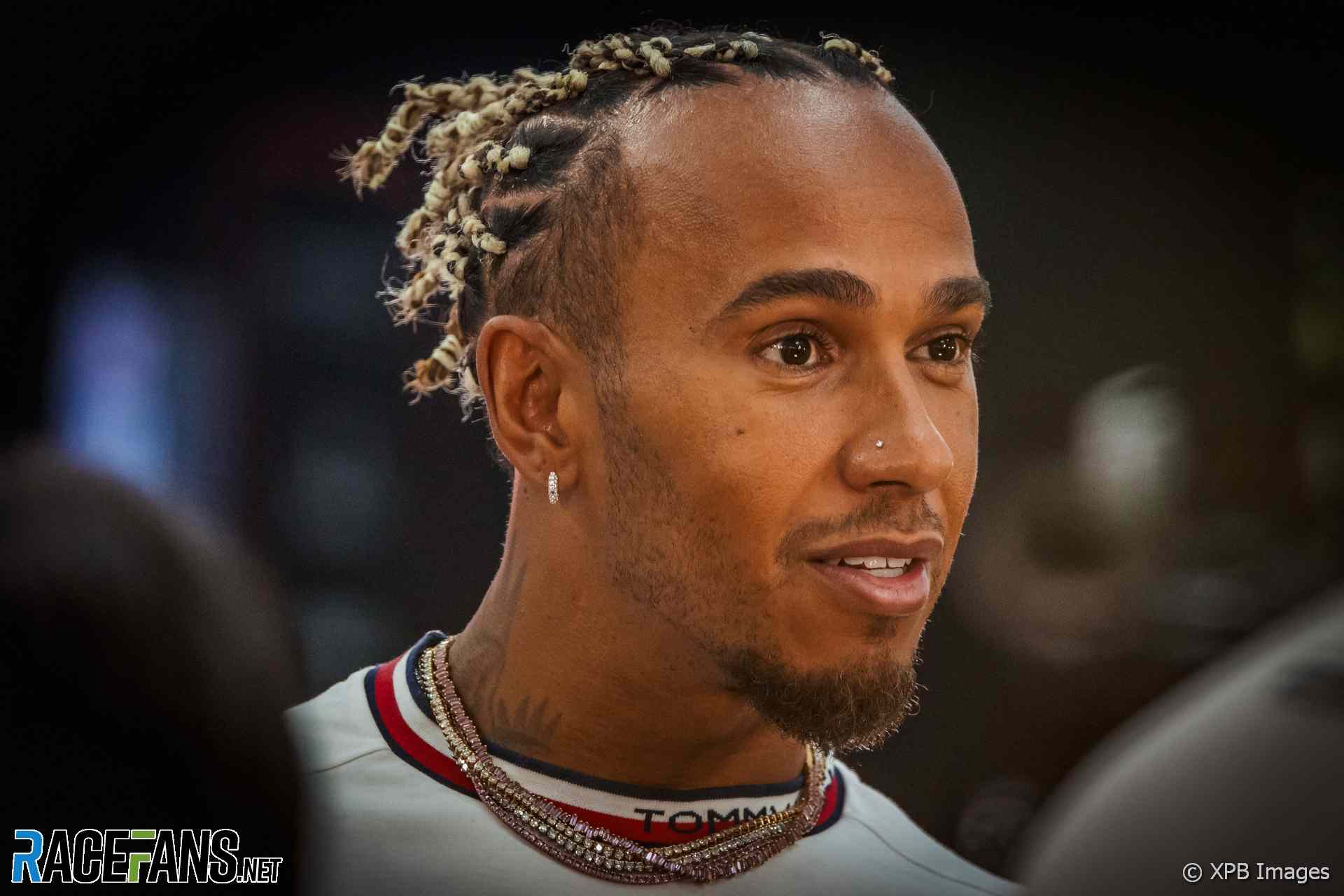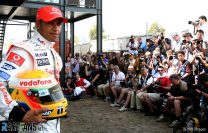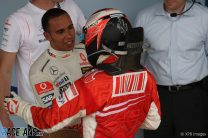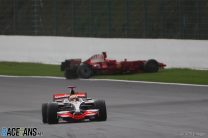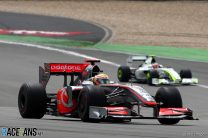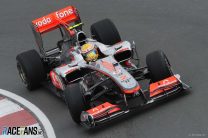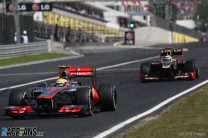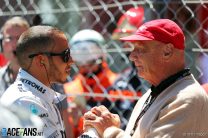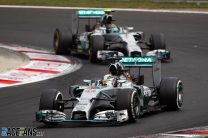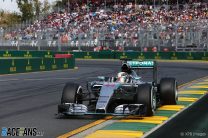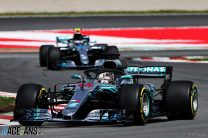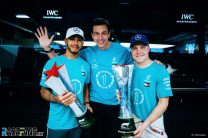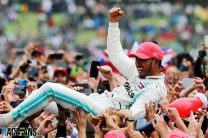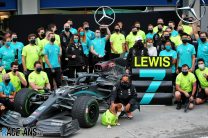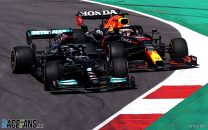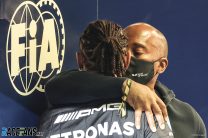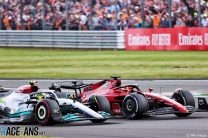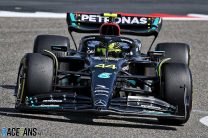Lewis Hamilton set himself on a path to Formula 1 when he introduced himself to McLaren team boss Ron Dennis at an award ceremony in 1995.
The nine year-old walked up to Dennis, asked for his autograph and said: “Hi. I’m Lewis Hamilton. I won the British championship and one day I want to be racing your cars.”
Birthplace: Stevenage, United Kingdom
Find all RaceFans readers who support Hamilton
Jump to
McLaren: 2007-2012
Mercedes: 2013-
It earned Hamilton the patronage and support of one of the top Formula 1 teams which, 13 years later, led to him making his debut as a grand prix driver with them.
Hamilton went on to equal and then outstrip the achievement of his hero Ayrton Senna, a former McLaren driver. He won seven world championships, matching the record set by Michael Schumacher, and became the first driver ever to record 100 grand prix victories.
Before that there was the small matter of graduating through the lower echelons of motorsport, which Hamilton achieved with some astonishing successes.
Lewis Hamilton biography
Karting
Hamilton’s first contact with motorsport came through driving remote controlled (RC) cars. His father Anthony bought him one in 1991 and aged six Hamilton was runner-up in a national RC racing championship. “I was racing these remote-controlled cars and winning club championships against adults,” remembered Hamilton. After that Anthony wondered if Lewis’s skills might transfer to full-size motorsport.
He began karting aged eight and two years later won the British karting championship (cadet class) and STP karting championship. Hamilton remained in cadet class karting in 1996, winning the Champions of the Future series and becoming Sky TV KartMasters Champion and Five Nations Champion. The following season he raced in Junior Yamaha and won the Champions of the Future series again, plus the Super One series, and was British Champion again.
At their first meeting Dennis had written in Hamilton’s autograph book, “Phone me in nine years, we’ll sort something out then.” In 1998 he was officially signed to the McLaren Driver Development Support programme. At 13, he was the youngest such driver to have been contracted by an F1 team. The contract guaranteed financial and technical support and even included a future option for entry into Formula One.
That year he graduated to the Junior Intercontinental A level and finished second in the McLaren Mercedes Champions of the Future and raced in the Italian Open Championship, finishing fourth. More Junior Intercontinental A success came in 1999. He was Vice European Champion, Trophy de Pomposa winner and finished fourth in the Italian Open Championship again.
That year he also raced in Intercontinental A and won the Italian ‘Industrials’ Championship. The next year of karting brought an even greater haul of wins. He was European Champion in Formula A, winning all four rounds.To that he added the World Cup Championship in Japan, won the Elf Masters at Bercy in France and the second round of the Italian Open. Recognising his success the British Racing Drivers’ Club made him a ‘Rising Star’ Member.
In 2001 he came up against Michael Schumacher who made a guest appearance at the German’s home track at Kerpen. Hamilton finished behind the Ferrari star, who by then had four world championships to his name.
Advert | Become a RaceFans supporter and
Formula Renault
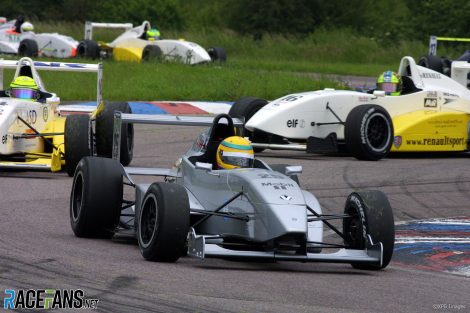
“McLaren asked us to give Lewis a test in our Formula Renault and tell them what we thought,” recalled team boss John Booth. “We took him to a general test day at Mallory Park. He’d never driven a car before, not even a road car – and he crashed our Renault after three laps! But the boys put it back together again, and he went back out and went very quickly. It hadn’t fazed him in the slightest.”
After placing fifth in the British Formula Renault Winter Series, the 2002 season saw Hamilton race in the full championship. Three wins saw him finish third in the championship won by the more experienced Danny Watts who out-scored him 333 to 274, the pair separate by Jamie Green.
Hamilton remained in the series the following year but took until the fifth round, at Silverstone, to take his first win. But from then on he dominated, winning all but one of the next ten races. Hamilton stormed to the title with ten wins, nine fastest laps, eleven pole positions, and 419 points to runner-up Alex Lloyd’s 371. He could even afford to miss the last two races.
Advert | Become a RaceFans supporter and
Formula Three

Nonetheless he returned to Formula Three in 2004 but in the Euroseries rather than the British championship. He stayed with Manor for their first appearance in the championship and won once at the tight Norising street track. This left him fifth overall behind champion Green, Alexandre Premat, Nicolas Lapierre and Nico Rosberg.
That year he also won the Bahrain F3 Superprix and race one of the Macau F3 Grand Prix. He had his first test in a McLaren F1 car in December, alongside Green and Lloyd.
Hamilton switched teams to champions ASM for 2005 and the outcome was reminiscent of his second-year domination of Formula Renault. He won 15 of the 20 races (plus a 16th at Spa-Francorchamps after which he and several other drivers were disqualified for a technical infringement) and beat team mate Adrian Sutil
That same year he won the F3 Marlboro Masters in Zandvoort, in the Netherlands, from pole position. He also won both the prestigious Monaco F3 Grand Prix races from pole position and both the Pau F3 Grand Prix in France from pole position.
GP2
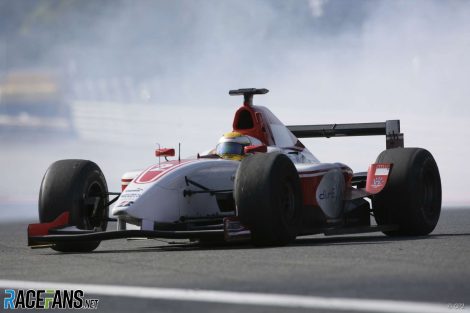
But his main championship rival would be another driver in his second year of GP2 – Nelson Piquet Jnr. The very first round set the tone for the season with Piquet winning from Hamilton.
The Briton found form quickly and won his first race at round five, at the Nurburgring. But this was more than just a win. It was a crushing display of superiority where, lapping over a second quicker than his rivals, even a penalty for speeding in the pit lane couldn’t stop Hamilton.
At Monte-Carlo he won again and he won both his home rounds at Silverstone. There he delivered a crucial blow to Piquet by flying past the Brazilian – and Clivio Piccione – in a celebrated move at the 150mph Becketts complex which saw the crowd roar in approval.
Piquet rallied later in the year but couldn’t keep Hamilton from the title. It came in unusual circumstances following the penultimate race at Monza when he inherited a bonus point for fastest lap from Giorgio Pantano, who was penalised for a yellow flag infringement.
The time was ripe for Hamilton to graduate to Formula One.
Hamilton’s F1 career
2007: McLaren
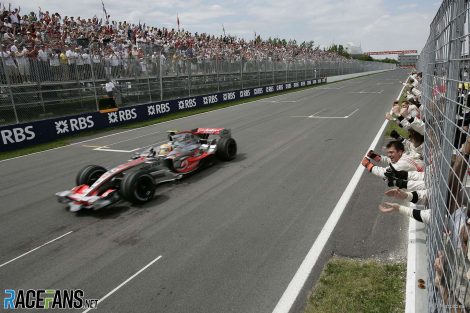
Despite facing competition from Pedro de la Rosa, who had substituted for Montoya in 2006, and fellow McLaren tester Gary Paffett, it was Hamilton who got the drive. He was told on September 30th but the news wasn’t made public until November 24th as McLaren did not want the announcement to be overshadowed by Michael Schumacher’s retirement.
“We reviewed the whole grid and when we looked at the drivers other than the top three there was no-one that really shone,” Dennis explained. ” [Hamilton] has been in the family for a long time and he deserves the opportunity we’re giving him.”
Hamilton’s astonishing debut season brought him instant fame beyond the motor racing world. He finished on the podium at his first race and kept it up for nine races in a row, winning at Montreal and Indianapolis.
That propelled him into the lead of the world championship by 12 points before Alonso mounted a fightback. But the season turned nasty – McLaren were accused of obtaining and using Ferrari information illegally – a controversy which quickly acquired the name ‘Spygate’.
In qualifying At the Hungarian Grand Prix, Hamilton ignored an instruction to allow Alonso past. His team mate reacted by holding Hamilton up in the pits, preventing him from starting his final qualifying run on time. The stewards penalised Alonso for impeding his rival, handing pole position to Hamilton, who won the race.
It later emerged that on the same weekend Alonso had threatened Dennis that he would expose his own role in the spying affair unless he was given number one status in the team. Dennis refused, and the working relationship between Alonso and the team crumbled. When further details of McLaren’s use of Ferrari information was revealed the team was hit with a massive fine and exclusion from the constructors’ championship while Alonso edged closer to Hamilton in the drivers’ standings.
Hamilton seemed to have Alonso beaten after winning in the wet at Fuji as his team mate crashed out. But Hamilton suffered a string of calamities, some self-inflicted, in the final two race. He retired from the Chinese Grand Prix when he slid off on worn tyres, and his gearbox cut out during the Brazilian Grand Prix, causing him to slip down the field and finish seventh. That allowed Kimi Raikkonen to nab the title by a single point ahead of the McLaren pair.
McLaren held a faint hope that Hamilton might become champion on appeal after several teams were suspected of using illegally cool fuel in the final race, but their protest was rejected.
Advert | Become a RaceFans supporter and
2008: McLaren
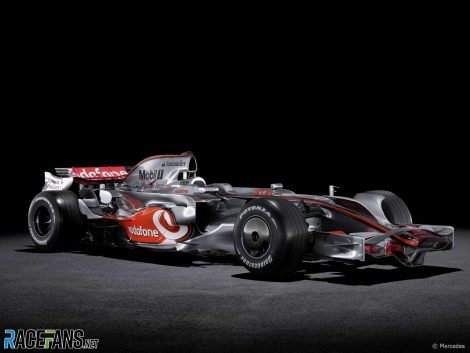
But Hamilton was less composed in his second season than he had been in his first. Serious mistakes spoiled his races at Bahrain, Canada, France and Japan.
These low points were interspersed with moments of genuine class – especially when it rained. At a soaked Silverstone he thrashed the opposition, crossing the finishing line a full minute before anyone else on the same lap.
Controversy dogged his title campaign, Hamilton picking up five separate penalties during the course of the season. Some of these were open-and-shut affairs: blocking traffic at Singapore, cutting the track at Magny-Cours. Others were controversial, none more so than at Spa, where he became only the second F1 driver ever to be stripped of a win post-race because of a driving infraction.
After a similar setback at Fuji he bounced back to dominate the Chinese Grand Prix, which set him up perfectly for a shot at the title in the final race. Not wanting to repeat the mistakes of 2007 he drove an ultra-conservative race at Interlagos, which ironically almost cost him the title again, before that famous last-lap switch secured the championship by a single point.
2009: McLaren
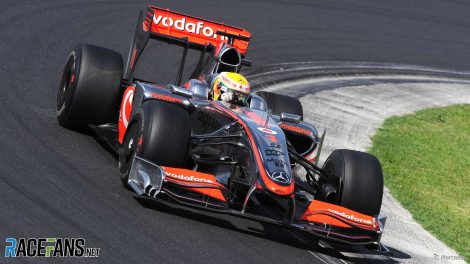
They soon found themselves in even more trouble as they were accused of lying during the first race of the season. The stewards decided Hamilton and his team had misled them bout how Trulli had ended up in front of Hamilton during a safety car period at the end of the race. Hamilton was disqualified from the results and made a frank apology to the world’s media at the next race in Malaysia.
It took half a season for the car to come good. When it did, Hamilton was back at the front, winning easily in Hungary at Singapore. By the end of the year he had climbed up to a wholly creditable fifth in the championship behind the Brawn and Red Bull drivers.
2010: McLaren
He bounced back in 2010 with the more competitive MP4-25 at his disposal. He led at the halfway point in the season after wins in Turkey and Canada.
A third win followed in Belgium but his championship campaign hit trouble shortly afterwards with collisions putting him out in Italy and Singapore.
He stayed in contention until the final round, where he finished second, leaving him fourth in the championship.
2011: McLaren

The season began promisingly enough with second place at Melbourne. This was an immense relief for the team which had suffered numerous problems with its new MP4-26 in testing.
Hamilton won the third race of the year in China in fine fashion, picking off his team mate, then hunting down and passing Vettel. It looked like business as usual for him.
But as the season went on it became increasingly clear Button was able to to get similar performance out of the new-specification Pirelli tyres without taking as much life out of them as Hamilton, Worse, Hamilton became involved in a string of incidents, many of them completely unnecessary.
He tangled with Webber and Button in Canada, Massa and Pastor Maldonado in Monaco. He clipped Komaui Kobayashi while passing him at Spa, spearing into the barriers.
Time and again Hamilton bounced off Massa’s Ferrari. He ran clean into the back of his rival in Singapore, prompting an angry outburst from Massa. He was summoned to the stewards time and again, and made matters worse at the Monaco Grand Prix with an ill-judged joke about the stewards pursuing him because of his skin colour. He later apologised.
Among the blunders there were moments when he was at the top of his game. Such as his consummate victory in Germany, outdoing Alonso and Webber in a tense, wheel-to-wheel battle. In Korea he became the only driver to break Red Bull’s monopoly on pole position.
But even as the season drew to its close Hamilton was running behind his team mate on the track. For the first time ever, he was also beaten in the points standings by the driver he shared a team with.
Advert | Become a RaceFans supporter and
2012: McLaren
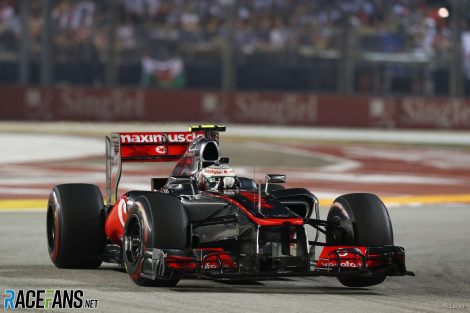
Hamilton was unable to convert pole position in the opening races into victories. Another chance was lost in Sub when he was sent to the back of the grid after running out of fuel during qualifying.
His first win of the season came in Canada and although further victories followed in Hungary, Italy and America, he to often found himself out of the points through no fault of his own.
As Hamilton neared the end of his five-year deal with McLaren there was much speculation over his future. To the surprise of many, he announced after the Singapore Grand Prix he would end his association with McLaren and join Mercedes.
2013: Mercedes
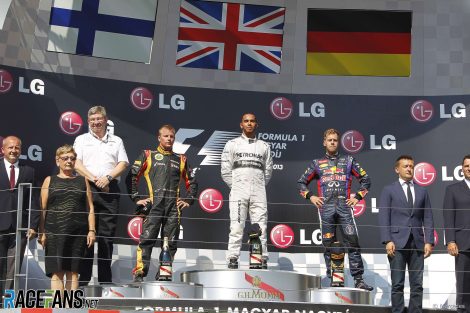
Only one of those wins was scored by Hamilton – the others were taken by Nico Rosberg at Monaco and Silverstone. But Hamilton led the latter before becoming the first of several drivers to suffer a tyre blow-out.
He took pole position five times during the year, but was only able to convert it into victory in Hungary, as Mercedes struggled with tyre wear in the first half of the season. By the latter half of the year he was still not entirely happy with the balance of his car, yet narrowly beat Rosberg in the points.
2014: Mercedes

The problems began at the very first race, where he retired with an engine failure shortly after starting from pole position. He reeled off a series of four wins in a row to reclaim the points lead from Rosberg, but at the middle of the session things threatened to get away from him.
Rosberg led him home in Monaco after a controversial incident in qualifying where Rosberg went off the track, causing the yellow flags to come out which prevented a suspicious Hamilton from improving his time.
Rosberg added wins in Austria and Germany, the latter coming after Hamilton suffered a brake failure in Q1. Incredibly his car let him down during the first phase of qualifying at the next race as well. This time Hamilton fought back to lead Rosberg home, albeit having disregarded an instruction from his team to wave the other car past at one point.
Matters came to a head in Belgium where Hamilton took the lead only to pick up a puncture while defending his position from Rosberg. Hamilton fumed, but set about reasserting himself with five wins on the trot.
The controversial double points season finale increased Rosberg’s chances of lifting the title – as did his fifth win of the year in Brazil, which came after Hamilton spun off. But when the final race came Hamilton was leading comfortably when the latest Mercedes reliability problem took his team mate out of the running for good.
2015: Mercedes
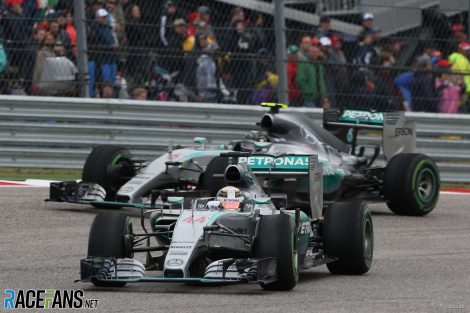
Having been out-qualified by Rosberg too often the previous year, Hamilton addressed the one significant weakness in his form with astonishing thoroughness: over the first 12 races he started from pole position 11 times. By converting the majority of those into victories he quickly put the outcome of the championship beyond doubt.
In July he won his home race for the third time – as he had in his previous two championship-winning campaigns. At this point he and Rosberg had finished every race on the podium, but while life would get more difficult for the team in the coming races it would largely be to Hamilton’s advantage in the championship.
A scrappy performance by the pair in Hungary saw Hamilton take sixth, two places ahead of Rosberg. The latter suffered the team’s first race-stopping technical failure of the year in Italy while Hamilton added another 25 points to his tally. Hamilton’s car failed him in Singapore, but the effect was lessened by the fact both drivers were running outside the top three in Mercedes’ least competitive showing of the year.
Rosberg led Hamilton out of turn one in Russia but he was to be disappointed by another breakdown while Hamilton took full advantage. That virtually decided the championship, and when an unforced error by Rosberg at the next race let Hamilton in to win again the championship was over.
Worryingly for Hamilton, Rosberg rallied over the next three races, winning each from pole position. That, and a stunning defeat in Monaco where an unnecessary pit stop dropped him from first to third, were the only significant disappointments in another tremendously successful campaign.
Advert | Become a RaceFans supporter and
2016: Mercedes

That advantage counted for little when, on more than one occasion, Hamilton’s car let him down. A series of power unit problems in qualifying compromised his starting position, and in Malaysia a shock failure while leading cost him a likely victory.
With Rosberg performing at his best and enjoying considerably better reliability from his car, these were serious setbacks. Though there were days when Hamilton didn’t perform to the best of his abilities – his starts were a particular weakness – he still won another ten races, one more than his team mate managed.
Hamilton went into the final four races needing to win them all to have a shot at winning the title. This he managed, but he also needed Rosberg not to finish on the podium. That never looked likely – not even as Hamilton defied the pleas of his team and slowed his pace, leaving Rosberg vulnerable to attack from their rivals. Second place gave Rosberg the title, whereupon he shocked the F1 world by walking out of the sport.
2017: Mercedes
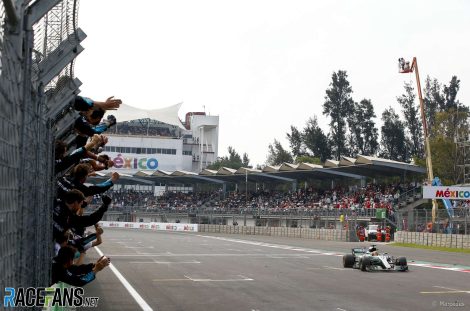
The change came amid a shake-up in the technical regulations. Crucially the power unit rules, the cornerstone of Mercedes’ success, remained unchanged. Nonetheless a resurgent Ferrari proved a serious new threat to Hamilton. Sebastian Vettel won the season-opening race in Australia.
The pair fought hard over the opening half of the season. Hamilton prevailed in a thrilling scrap in Spain, but two weeks later in Monaco he struggled with his unco-operative chassis to a distant seventh. A likely win went begging in Azerbaijan when his headrest failed. This came after a contentious incident where Vettel ran into him during a Safety Car period.
Bottas had put up a strong fight too, winning in Russia and Austria. By mid-season it seemed the team had finally got to grips with its new car and Hamilton dominated his home race while a puncture scuppered Vettel.
After the summer break Hamilton asserted himself, reeling off a string of wins in Belgium, Italy and Singapore. The latter was a surprise win on a track which didn’t suit the W08, aided by a first-lap crash which wiped out both Ferraris and Max Verstappen.
Having trailed Vettel early in the season, suddenly Hamilton was leading the table. That was boosted yet further when technical problems for Ferrari in the next two races badly limited Vettel’s ability to score points.
A championship which had been close now seemed a formality. Hamilton took another step to a fourth world title by winning in the USA, passing Vettel on the way. His attempt to do the same on the first lap in Mexico went awry – the pair tangled and fell to the rear of the field. But with Vettel unable to recover to the second place he needed to stay in contention, Hamilton clinched the title with a lowly ninth place.
2018: Mercedes
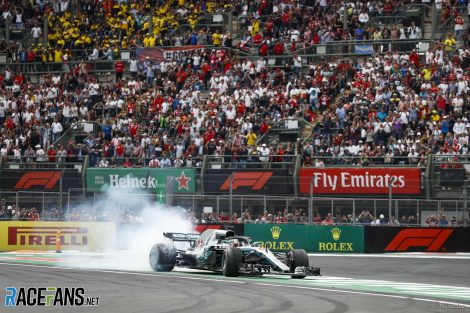
While Ferrari hit their stride – Vettel won round two in Bahrain as well – Hamilton found the W09 a trickier proposition than his team mate did in the opening races. He scored his first win at the fourth race in Azerbaijan, but only after a puncture robbed Bottas of victory.
While Austria and Francx yielded emphatic wins for Hamilton, elsewhere Ferrari made gains. He took pole at home, but was bundled off on the first lap by Raikkonen. Nonetheless he rallied to take second behind Vettel.
He had revenge in Germany, where he won brilliantly from 14th after Vettel skated off in the rain. A series of further errors by Vettel handed Hamilton the initiative: he won again in Italy and in Singapore, the latter following an exceptional qualifying lap which was vintage Hamilton.
For the second year running he sealed the title in Mexico. But this time he kept up the pressure, adding further wins in Brazil and Abu Dhabi, With five world championships and 73 race wins, Schumacher’s records were now in sight.
2019: Mercedes
Ferrari looked strong in pre-season testing, and Bottas won the first race of the 2019 season. Was Hamilton’s supremacy finally under threat? He hit back emphatically, winning the next two races, though he was aided by Charles Leclerc’s Ferrari failing in Bahrain.In the W10, Hamilton lacked his usual edge over a single lap, and Bottas claimed a trio of pole positions in a row. But a string of race wins moved Hamilton ahead of his team mate in the championship. The pair went wheel-to-wheel at Silverstone, and Hamilton prevailed again, thanks in part to a Safety Car. Then just before the summer break, Bottas slumped, adding just four points to his tally in Germany and Hungary while Hamilton drew clear.
Ferrari took the upper hand after the summer break, claiming six pole positions in a row, but their drivers were already too far behind in the championship. Hamilton came from behind to win in Russia and Mexico, meaning that with three races to go his sixth title was virtually assured. Although Bottas denied him victory at the Circuit of the Americas, second place for Hamilton sealed title number six.
2020: Mercedes
Hamilton’s 2020 was, like any driver racing under the coronavirus pandemic, an exceptional year. Unlike any other driver, however, he broke seemingly-unbeatable records while balancing a more political life off-track.
Following the suspension of the 2020 season due to COVID-19, Hamilton filled the months without racing – the longest gap in his career since he was in karting – with activism. He became known for making statements on human rights and in particular racial inequality, heavily inspired by the Black Lives Matter movement in the wake of the death of American George Floyd in police custody.
Any hope his rivals might have had that this would distract him from on-track achievement, when the season finally restarted, was short-lived. Hamilton missed the first win of 2020, clumsily handing it to teammate Bottas with a series of errors including clashing with Alex Albon for the second time in three races but it wasn’t to become a pattern.
During the 2020 season Hamilton took more than half the race victories, finishing the year as both the driver with the most Grands Prix wins ever and an equal to Michael Schumacher on seven world drivers’ championship victories.
2021: Mercedes
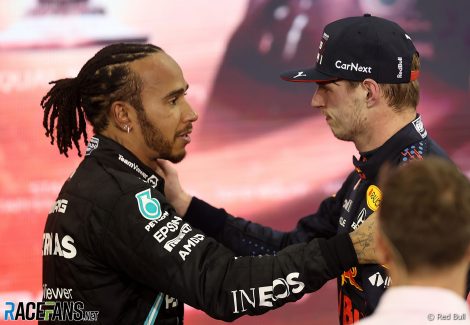
Despite the testing troubles, Hamilton was able to win the opening round of the season in Bahrain and hold off polesitter Max Verstappen. It signaled the beginning of a titanic, year-long duel between the pair for the drivers’ championship.
Trading the championship lead with the Red Bull throughout the season, Hamilton would continue to break records. He broke through the 100 pole positions barrier at the Spanish Grand Prix and followed that with his 100th race victory in Russia.
He continued to loudly advocate for social justice and causes he believed in and adopted the LGBT+ Pride flag on his helmet for the final three rounds of the season – each in nations with restrictive laws against LGBT+ people.
But his battle with Verstappen was one laced with controversy. A high-speed clash with his rival in Silverstone marked a turning point in the battle and saw Verstappen taken out of the race while Hamilton overcame a time penalty to win. The two collided again in Monza where both were unable to continue, before clashing yet again in Saudi Arabia in a race that saw Hamilton draw level on points heading into the final race of the season.
The championship decider was one that Hamilton appeared in control in for most of the race around the Yas Marina circuit. Hamilton had lead most of the race after beating Verstappen off the line, but a late safety car allowed Verstappen to pit from second for fresh tyres. Race director Michael Masi eventually decided to allow only the five lapped cars between Hamilton and Verstappen by the safety car, making Hamilton extremely vulnerable to Verstappen on the restart. Hamilton lost the lead of the race and the championship on the final lap as Mercedes immediately protested the result in disgust.
Mercedes later opted not to press ahead with an appeal at the FIA’s International Court of Appeal, confirming that Hamilton would lose his world championship title to Verstappen. Although initially congratulating Verstappen on the podium after the race, Hamilton left the circuit and offered no public comment for months.
2022: Mercedes
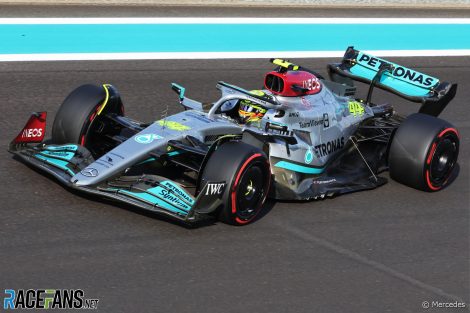
Hamilton started the new season with a fortuitous podium finish in Bahrain, but Mercedes’ car was not competitive enough to continue racking up trophies and he went the next seven races without visiting the podium.
Upgrades brought Mercedes closer to the front in the second half of the season, and Hamilton racked up five consecutive podium finishes including a runner-up spot at the Hungarian GP where he took fastest lap and was in contention to win.
There were further struggles for Mercedes following that, but Hamilton was able to claim another three second place finishes late in the year – and fight Verstappen for United States Grand Prix win – to come sixth in the standings. Despite the drop in form, it was enough to motivate Hamilton to continue his F1 career and he spoke often about there being a strong chance he would extend his Mercedes contract beyond 2023.
2023: Mercedes
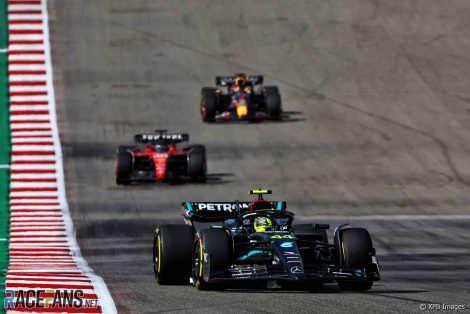
Soon after the season began Mercedes dispensed with the novel ‘zero’ sidepod design which was seen as the distinguishing feature of its first ground effect cars. But although the W14 improved over the course of the season it never offered a consistent threat to Red Bull, who won all bar one of the 22 grands prix.
Even before its major makeover the W14 performed well enough at some tracks for its drivers to claim podium finishes. Hamilton took his first in Melbourne with second place, a result he repeated in Catalunya and Mexico City. He also crossed the line second at the Circuit of the Americas, just two seconds behind the victorious Verstappen, in what appeared to be the team’s best performance of the season. However it new floor touched the track surface harder than expected, wearing away too much of its legality plank, and Hamilton was disqualified.
That severely compromised his chances of beating Verstappen’s team mate Sergio Perez to second place in the drivers’ standings. He came in third, but a massive 341 points behind Verstappen.
Lewis Hamilton’s career in pictures
Lewis Hamilton articles
Featured articles
- Hamilton’s route to F1
- Hamilton wins the 2008 F1 title and becomes youngest world champion
- Five years, over 35 incidents: Has Hamilton been treated fairly?
- Hamilton joins Mercedes for 2013 after McLaren exit
- Part-time racer? The facts of Hamilton’s ‘jet-set lifestyle’
Latest articles
- Verstappen set to overtake Hamilton’s career race-winning rate at next round
- “I’m insanely slow, man…” – Every message from Hamilton’s Shanghai slog
- Alonso and Hamilton used unconventional strategies, but one worked better
- Hamilton takes responsibility for “bad set-up change” after poor race
- Vote for your 2024 Chinese Grand Prix Driver of the Weekend
Lewis Hamilton books
- “My Story” (Hamilton, 2007)
- “Hamilton: The Full Story” (Mark Hughes, 2007)
- “Hamilton” (Andrew van de Burgt, 2007)
- “Hamilton: New Kid on the Grid” (Ian Stafford, 2007)
- “Hamilton: The People’s Champion” (Bruce Jones, 2007)
- “Hamilton – The Story So Far” (Gareth Rogers, 2007)
- “Hamilton: A Dream Comes True” (Brian Belton, 2007)




